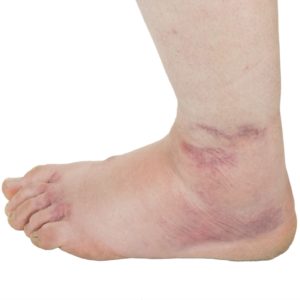 The title of this blog is a question I get asked quite frequently at my practice. However, we can’t always answer it with a simple explanation because there could be a number different factors at play. Today, we take a closer look at some of those factors and try to give you a better idea of why your ankles are swollen.
The title of this blog is a question I get asked quite frequently at my practice. However, we can’t always answer it with a simple explanation because there could be a number different factors at play. Today, we take a closer look at some of those factors and try to give you a better idea of why your ankles are swollen.
Understanding Swollen Ankles
Some of the causes of ankle swelling are obvious, while others are not so apparent. Here’s a closer look at some of the more common causes.
Acute Trauma – This is one of the more obvious causes of swelling. If your ankle got stepped on during a soccer game or you rolled it while stepping on some uneven ground, odds are you’ll experience some localized swelling. If you ankle is swollen and you distinctly remember suffering an injury, treat it with rest, ice, compression and elevation to help the swelling subside. That being said, if pain doesn’t resolve or gets worse, visit a foot specialist as you may have a fracture.
Gout – We’ve talked about gout on the blog before, but it involves the accumulation of uric acid crystals in some joints in your feet. These crystals can cause regionalized inflammation and swelling. Gout attacks typically set in if you have a poor diet, excessive alcohol intake and limited exercise. By watching what you eat, cutting back on alcohol and getting regular exercise, you can greatly reduce gout-induced swelling.
Infection – Infections can cause swelling, but an infection of the ankle is very rare unless you have an open sore or recently underwent a surgery on the ankle or foot. Medications can usually help defeat an infection that is causing swelling, so if you think an infection is the problem, visit a doctor as soon as possible.
Arthritis – Arthritis can lead to degenerative changes in the joints, and as surfaces begin to move less freely in the area, they can create friction-induced inflammation and swelling in the area. Compression wraps, elevation and an exercise program from your foot specialist can help combat arthritis-induced swelling.
Bone Spurs – Bones spurs can develop on their own or in conjunction with arthritis. These bone calcification segments can – you guessed it – cause inflammation that leads to swelling. Some may resolve on their own with activity and exercise, but others are best treated with surgery to remove the spur.
Circulation Issues – Conditions like vascular obstruction or peripheral edema both lead to reduced circulation in our ankles and feet. Obstructions and edemas can lead to swelling in the ankle, and circulation issues should always be examined by a doctor.